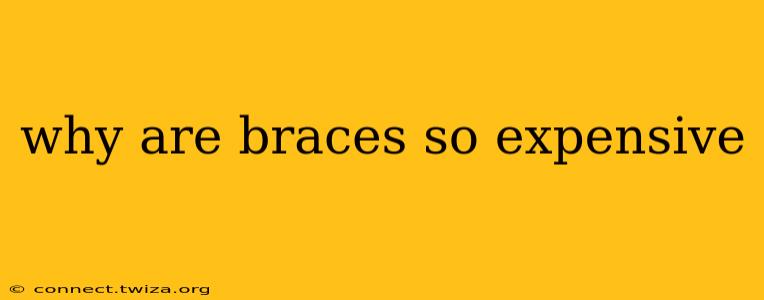Why Are Braces So Expensive? Unpacking the Costs of Orthodontic Treatment
The high cost of braces is a common concern for many families. Understanding the factors contributing to this expense requires looking beyond the simple price tag and delving into the complexities of orthodontic care. This article will explore the various reasons why braces are so expensive, addressing common questions and misconceptions.
What are the main factors driving up the cost of braces?
Several key factors contribute to the high cost of braces:
-
Specialized Expertise and Training: Orthodontists undergo extensive education and training beyond general dentistry. This specialized expertise, requiring years of additional schooling and rigorous examinations, directly impacts their fees. They possess a deep understanding of complex jaw and tooth alignment issues, demanding a higher level of compensation for their advanced skill set.
-
Advanced Technology and Materials: Modern orthodontic treatments utilize sophisticated technology, including digital imaging, 3D scanning, and computer-aided design (CAD) for customized treatment plans. The materials themselves, such as high-quality brackets, wires, and other appliances, are also relatively expensive to produce and source. These advanced tools and materials enhance treatment precision and efficiency but contribute to the overall cost.
-
Lengthy Treatment Time: Orthodontic treatment is a long-term commitment, often spanning one to three years or even longer, depending on the complexity of the case. This extended treatment period increases the overall cost because of the numerous appointments, adjustments, and monitoring required throughout the process.
-
Labor Intensive Care: Each orthodontic appointment involves a significant time investment from the orthodontist and their staff. This includes comprehensive examinations, detailed treatment planning, meticulous appliance adjustments, and ongoing monitoring of progress. The labor-intensive nature of the work contributes significantly to the final cost.
-
Overhead Costs: Orthodontic practices, like any medical office, incur considerable overhead costs, including rent or mortgage payments, staff salaries, insurance, utilities, and equipment maintenance. These expenses are factored into the overall pricing structure.
-
Multiple Appointments: The treatment process often requires numerous appointments for adjustments, monitoring progress, and addressing any complications. The cumulative cost of these regular visits contributes to the overall expense.
Are there cheaper alternatives to traditional braces?
Yes, several more affordable alternatives to traditional metal braces exist, although their effectiveness may vary depending on the individual's specific needs:
-
Invisalign: While generally more expensive than traditional metal braces upfront, Invisalign aligners offer a more discreet treatment option. The cost can vary widely based on the complexity of the case.
-
Lingual Braces: These braces are attached to the back of the teeth, making them invisible. However, they're typically more expensive and can be more challenging to adjust than traditional braces.
How can I make braces more affordable?
Several strategies can help make braces more affordable:
-
Dental Insurance: Check your dental insurance plan to see what orthodontic coverage it offers. Many plans provide partial coverage, significantly reducing out-of-pocket expenses.
-
Payment Plans: Most orthodontic practices offer various payment plans to make treatment more manageable financially. Explore options such as monthly installments or financing arrangements.
-
Early Intervention: Early orthodontic assessment can sometimes identify and address minor issues before they become more complex and costly to treat.
-
Shop Around: Comparing prices from different orthodontic practices in your area can help you find the most cost-effective option without compromising quality of care.
Why is it so expensive compared to other dental procedures?
The expense of braces differs significantly from other dental procedures due to the complexity, duration, and specialization involved. Other dental procedures, such as fillings or cleanings, are often less time-consuming and don't require the same level of specialized training and technology. Orthodontic treatment is a long-term investment in improving oral health and overall facial aesthetics, justifying the higher cost.
By understanding the various factors contributing to the cost of braces, individuals can make informed decisions about their orthodontic treatment and explore options to manage the associated expenses more effectively. Remember to consult with your orthodontist to discuss treatment options and financing plans that best suit your individual needs and budget.
